The first European settlers in New Zealand dismissed the tuatara as just another lizard, of no particular interest for food or skin. But when scientists examined the two-pound creature more closely, they discovered that it was not really a lizard at all: The tuatara was the sole surviving member of the Sphenodons, reptiles that were contemporary with dinosaurs and thought to have been extinct for more than 180 million years.
Virtually unchanged through nearly two million centuries, the tuatara has features that distinguish it from modern reptiles. Perhaps the most unusual is a third eye in a socket atop its head, unable to perceive images but sensitive to light and heat. Scientists believe it functions as a thermostat, telling the tuatara when it is time to get out of the sun. Though sluggish and slow to reproduce, the creature is a virtual ball of fire at low temperatures. Other reptiles become paralyzed when the mercury falls much below fifty degrees Fahrenheit. But the tuatara remains active down to forty-three degrees, which may explain why it survived climatic swings that extinguished other reptilian species.
Easy prey to almost any mammalian predator, the tuatara's continued existence depends on isolation. They were completely exterminated on New Zealand's two main islands by 1850, wiped out by the rats and other animals that accompanied human settlers. But colonies totaling about 50,000 tuataras survive on small islands off the coast. In these protected outposts, the relic reptiles display remarkable longevity in their own right: Most of them live to an age of sixty or older.
